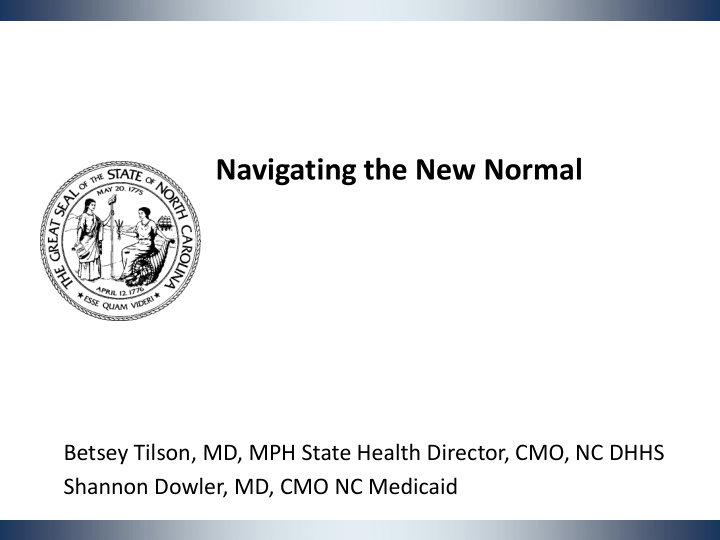



Navigating the New Normal Betsey Tilson, MD, MPH State Health Director, CMO, NC DHHS Shannon Dowler, MD, CMO NC Medicaid
2
3
14
15
May need to dial the dimmer switch up or down depending on Trends Tightened Tighten Loosen Tighten Loosen Loosen 16
Overall Guiding Principles for the New Normal Guiding Principles Objectives 1. Increase social distancing Structural/physical space modification to enforce distance Limit density Minimize opportunity for sustained exposure 2. Implement hygiene protocols Disinfecting surfaces and common spaces Systematic hygiene routines 3. Monitor workforce Establish and enforce sick policy to support and participant health disease suppression Implement systematic symptom screening Recommend resiliency and support resources 4. Protect vulnerable populations Identify and protect high risk for severe disease 5. Provide education to build Proactive information dissemination awareness and combat Identify and address misinformation misinformation 17
Outpatient and Ambulatory Settings • Continue some element of Triage and Telehealth • Infection Prevention and Control Guidance • Hierarchy of controls and Preservation Strategies – Engineering, Administrative, and Personal Protective Equipment Controls 18
Infection Prevention and Control Guidance 19
Requesting PPE • https://www.ncdhhs.gov/divisions/public-health/covid19/health-care-providers- hospitals-and-laboratories/requesting-ppe • Other Health Care Facilities 20
Operationalizing some other things • Well child visits − Prioritize well child care/ vaccination through 24 months of age − New medicaid well child visit telehealth guidance • COVID-19 surveillance − https://flu.ncdhhs.gov/providers.htm - ILINet provider application in the link at the bottom of the page anita.valiani@dhhs.nc.gov or at erica.wilson@dhhs.nc.gov. 21
22
New Coverage Requests? Email Medicaid.COVID19@dhhs.nc.gov
Telehealth Provision Opinions: Top 5 to Preserve?* • Telehealth Payment Parity • Telemedicine • Telephonic Reimbursement(Parity/Original) • Telepsychiatry • MD to MD Consultation *Informal Snapshot of Early Survey Results from Telehealth Workstream Members to Identify the TOP 5 provisions to consider keeping on after the State of Emergency
HHS Launches COVID-19 Uninsured Program Portal On April 27, HHS launched a claims portal to reimburse providers and facilities for COVID-19- related testing and treatment for uninsured individuals. • As part of the CARES Act and the Families First Coronavirus Response Act, the U.S. Department of Health and Human Services (HHS) will provide reimbursement at Medicare levels to providers and facilities for COVID-19-related testing and treatment of the uninsured. • Health care providers must register through the COVID-19 Uninsured Program Portal to participate in the program. Once registered, providers may request claims reimbursement through the portal beginning May 6, 2020 and can bill for qualifying services back to February 4, 2020. Providers can expect to begin receiving reimbursement in mid-May. • Program and portal training will be available April 29-30, 2020 (see portal for details). • More information about the program, including details about covered services, is available here. HRSA also maintains a frequently asked questions (FAQ) page about the program here. 28
29
Modeling COVID-19 in North Carolina: Update for the North Carolina Medical Society Aaron McKethan, PhD Senior Policy Fellow, Margolis Center for Health Policy, Duke University Adjunct Professor, Duke University School of Medicine CEO, NoviSci, Inc. May 6, 2020
Key Parameters April 22 model (brief published April 28) April 4 model (brief published April 6) Composite “weather forecast” of three models “Uncertainty analysis” varying key parameters evaluating hospital capacity under “maintain” of one of the models from the prior forecast. and “lift” scenarios How many total infections? What is the probability demand will exceed How many people require hospitalization? hospital supply? 25x multiplier for known cases 10x multiplier for known cases 4.4% hospitalization 2.2% hospitalization 30% require ICU 30% require ICU 14-day length of stay. 14-day length of stay. Scenario 1 (“Maintain”) Simulation 1 (Blue) samples approximated R 0 Sampled R e between 0.9 and 1.3 Simulation 2 (Yellow) between 1.3 and 2.5 Scenario 2 (“Lift”) Sampled R e between 1.3 and 2.0 samples approximated R 0 Simulation 3 (Red) between 2.5 and 3.0 after the Sampled R e between 2.0 and 2.5 end of April
Composite Estimates Across 3 Models (April 6)
Estimated Cumulative Infections (reported + unreported) for 3 Scenarios (April 28)
Acute Bed Demand Estimates for 3 Scenarios (April 2 8 )
ICU Bed Demand Estimates for 3 Scenarios (April 2 8 )
Key Take-aways We will likely begin the month of May with lower- than-expected viral spread. We have immediate and near-term hospital capacity available. The announced gradual reopening plan is a phased approach. Despite these notes of near-term optimism, it is very important to avoid a sense of complacency about the potential impact of COVID-19. As the state continues to expand the scale of its public health response (e.g., testing, contact tracing, etc.), we must continue to monitor short- term COVID-19 trends and act quickly to mitigate rapid upswings.
Recommend
More recommend